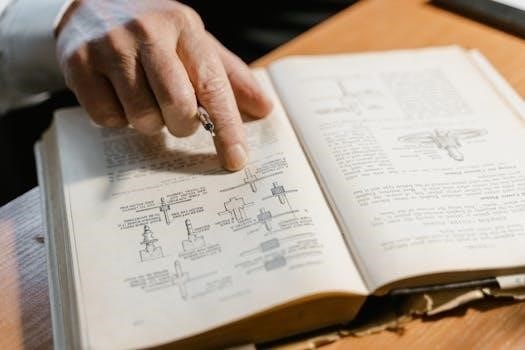Illinois Technical Reference Manual (IL-TRM)⁚ An Overview
The Illinois Statewide Technical Reference Manual‚ or IL-TRM‚ serves as a vital resource for calculating energy and capacity savings․ It provides transparent‚ consistent methodologies for evaluating energy efficiency programs․ The IL-TRM outlines savings algorithms from standard energy efficiency measures‚ ensuring reliable resource savings estimations․
Purpose of the IL-TRM
The primary purpose of the Illinois Technical Reference Manual (IL-TRM) is to establish a clear and consistent framework for quantifying the energy and capacity savings resulting from energy efficiency initiatives across Illinois․ This involves providing standardized methodologies and algorithms for calculating savings in both electricity (kWh) and natural gas (therms)‚ as well as electric capacity (kW)․
By offering a transparent and well-documented approach‚ the IL-TRM ensures that all stakeholders‚ including utilities‚ program administrators‚ and evaluators‚ are using the same baseline assumptions and calculation methods; This promotes fairness and comparability in assessing the impact of various energy efficiency measures․
Furthermore‚ the IL-TRM serves as a valuable tool for planning and evaluating energy efficiency programs․ It enables program designers to estimate the potential savings from different measures and to select the most cost-effective options․ The IL-TRM also supports rigorous evaluation of program performance by providing a consistent basis for comparing actual savings to projected savings․ Ultimately‚ the IL-TRM contributes to the efficient and effective deployment of energy efficiency resources throughout the state of Illinois․

IL-TRM Versions and Updates
The IL-TRM undergoes periodic updates to incorporate new technologies and refine calculation methodologies․ These versions ensure the manual remains relevant and accurate․ Updates include errata and reflect stakeholder input‚ promoting continuous improvement of savings estimations․
IL-TRM Version 13․0 (Effective January 1‚ 2025)
The Illinois Statewide Technical Reference Manual Version 13․0‚ effective January 1‚ 2025‚ represents the latest iteration of this crucial document․ This version incorporates updated methodologies and data for calculating energy and capacity savings from various energy efficiency measures․ It’s designed to provide a transparent and consistent basis for evaluating programs across Illinois․
Version 13․0 includes final versions of the IL-TRM and associated errata․ The structure follows previous versions‚ with separate volumes dedicated to overview/user guide‚ commercial/industrial measures‚ and residential measures․ Specific updates and revisions are documented to ensure clarity․ Stakeholders can use it to assess energy efficiency initiatives․
This recent version reflects ongoing efforts․ This version is a product of collaboration and technical expertise․ Version 13․0 ensures that energy savings calculations are accurate‚ reliable‚ and aligned with best practices․ It supports informed decision-making in the energy efficiency sector․
Past IL-TRM Versions
The Illinois Statewide Technical Reference Manual has undergone several revisions․ Each past version reflects evolving knowledge of energy efficiency measures․ These prior versions provide a historical context․ They show the evolution of calculation methodologies․ Examining past IL-TRM versions is useful․ It helps in understanding the changes․ It helps in understanding the drivers behind the current version․
Previous versions‚ such as Version 6․0‚ Version 7․0‚ Version 8․0‚ Version 11․0‚ and others‚ each had unique updates․ These included changes to measure calculations‚ new measures added‚ and refinements․ Each of these was based on field data and technological advancements․ These past versions showcase the commitment to accuracy․ They showcase the commitment to relevance in a changing energy landscape․
While superseded by newer editions‚ these older IL-TRMs remain valuable resources․ They help illustrate the development and refinement of energy efficiency evaluation․ Researchers‚ policymakers‚ and program administrators could find these older versions useful․ They are useful for historical analysis and comparative studies․ They offer insights into the progression of energy efficiency practices․

IL-TRM Structure and Content
The IL-TRM is organized into multiple volumes․ Volume 1 provides an overview and user guide․ Volume 2 focuses on commercial and industrial measures․ Volume 3 details residential measures․ Each volume offers specific guidance for calculating energy savings across different sectors․
Volume 1⁚ Overview and User Guide
Volume 1 of the Illinois Technical Reference Manual (IL-TRM) serves as an essential introduction and navigational tool for users․ This volume provides a comprehensive overview of the IL-TRM’s purpose‚ scope‚ and application․ It details the methodologies used for calculating energy savings and capacity reductions across various efficiency measures․
The user guide section offers step-by-step instructions on how to effectively utilize the IL-TRM․ It clarifies key terminologies‚ definitions‚ and assumptions employed throughout the manual․ Volume 1 also outlines the structure of the IL-TRM‚ explaining the content and organization of subsequent volumes‚ including commercial‚ industrial‚ and residential measures․
Furthermore‚ this volume includes guidance on interpreting the results of energy savings calculations and applying them in program planning and evaluation․ It addresses common questions and challenges encountered by users‚ providing practical solutions and recommendations․ Version updates‚ errata‚ and important notices are also documented in Volume 1‚ ensuring users have access to the most current and accurate information․
Overall‚ Volume 1 equips users with the foundational knowledge and practical skills necessary to navigate and leverage the full potential of the IL-TRM for informed decision-making in energy efficiency initiatives․
Volume 2⁚ Commercial and Industrial Measures
Volume 2 of the Illinois Technical Reference Manual (IL-TRM) is dedicated to providing detailed information on energy efficiency measures applicable to commercial and industrial facilities․ This comprehensive section outlines specific technologies‚ strategies‚ and practices that can reduce energy consumption and demand in these sectors․ Each measure is thoroughly described‚ including its applicability‚ installation requirements‚ and operational considerations․
The volume presents methodologies for calculating energy savings (kWh and therms) and capacity reductions (kW) associated with each measure․ These calculations are based on engineering principles‚ industry best practices‚ and empirical data․ Volume 2 also addresses interactive effects‚ such as the impact of lighting upgrades on HVAC loads‚ to ensure accurate savings estimations․
Furthermore‚ this section includes information on relevant codes‚ standards‚ and regulations that govern the implementation of energy efficiency measures in commercial and industrial settings․ It provides guidance on verifying and validating energy savings‚ including measurement and verification (M&V) protocols․ Case studies and examples are presented to illustrate the application of the measures and calculation methodologies in real-world scenarios․
Volume 2 serves as an indispensable resource for energy efficiency program designers‚ implementers‚ and evaluators working in the commercial and industrial sectors‚ enabling them to accurately quantify and promote the benefits of energy-saving initiatives․
Volume 3⁚ Residential Measures
Volume 3 of the Illinois Technical Reference Manual (IL-TRM) focuses specifically on energy efficiency measures applicable to residential buildings․ This volume provides detailed methodologies and parameters for calculating energy and demand savings associated with various residential energy efficiency upgrades and practices․ It covers a wide range of measures‚ including improvements to building envelope‚ HVAC systems‚ lighting‚ and appliances․
For each residential measure‚ Volume 3 offers comprehensive information on applicability criteria‚ installation guidelines‚ and data requirements for calculating savings․ It includes deemed savings values‚ algorithms‚ and simulation methodologies for estimating the energy and demand impacts of the measures․
The volume also addresses factors such as climate conditions‚ building characteristics‚ and occupant behavior‚ which can significantly influence energy savings in residential buildings․ It provides guidance on how to account for these factors in savings calculations․ Furthermore‚ Volume 3 incorporates information on relevant codes‚ standards‚ and regulations that govern residential energy efficiency in Illinois․
This section is designed to support program administrators‚ contractors‚ and homeowners in evaluating and implementing residential energy efficiency projects․ By providing a standardized and transparent approach to savings calculations‚ Volume 3 facilitates the effective design‚ implementation‚ and evaluation of residential energy efficiency programs across the state․

Calculating Energy and Capacity Savings
The Illinois Technical Reference Manual (IL-TRM) provides the methodologies and parameters necessary for accurately calculating energy and capacity savings resulting from energy efficiency measures․ These calculations form the bedrock of evaluating program effectiveness and ensuring consistent reporting across all stakeholders․
The IL-TRM offers a transparent framework‚ outlining specific algorithms and equations for various measures․ These calculations consider factors such as baseline energy consumption‚ installed equipment efficiency‚ operating hours‚ and applicable climate conditions․ The manual differentiates between energy savings (kWh or therms) and capacity savings (kW)‚ recognizing their distinct impacts on the electricity grid and natural gas distribution systems․
Furthermore‚ the IL-TRM emphasizes the importance of using appropriate data sources and measurement protocols to ensure the accuracy of savings estimates․ It provides guidance on data collection methods‚ sample sizes‚ and statistical analysis techniques․
The manual also acknowledges the inherent uncertainties in energy savings calculations and offers methods for quantifying and managing these uncertainties․ Sensitivity analysis and Monte Carlo simulations are among the techniques recommended for assessing the robustness of savings estimates․
By adhering to the IL-TRM’s guidelines‚ stakeholders can confidently calculate and report energy and capacity savings‚ promoting transparency and accountability in energy efficiency programs throughout Illinois․

Technical Advisory Committee and Measure Updates
The Illinois Technical Reference Manual (IL-TRM) is not a static document; it undergoes regular updates to reflect technological advancements‚ evolving energy efficiency practices‚ and feedback from stakeholders․ A crucial element in this process is the Technical Advisory Committee (TAC)․
The TAC comprises a diverse group of experts‚ including utility representatives‚ energy efficiency professionals‚ researchers‚ and regulatory staff․ This committee plays a vital role in reviewing existing measures‚ evaluating proposed new measures‚ and providing technical guidance on calculation methodologies․
The process for measure updates begins with a structured submission process‚ encouraging stakeholders to propose new measures or modifications to existing ones․ The TAC then rigorously evaluates these proposals‚ considering factors such as energy savings potential‚ cost-effectiveness‚ and applicability across different sectors․
Public input is also an essential component of the update process․ Draft versions of updated measures are released for public comment‚ allowing stakeholders to provide feedback and raise concerns․ The TAC carefully considers this feedback before finalizing the updates;
These updates ensure that the IL-TRM remains current‚ relevant‚ and aligned with the latest industry best practices‚ promoting accurate and reliable energy savings calculations for energy efficiency programs in Illinois․ This continuous improvement cycle enhances the IL-TRM’s value as a resource․
Applications of the IL-TRM
The Illinois Technical Reference Manual (IL-TRM) serves as a cornerstone for numerous applications within the energy efficiency landscape of Illinois․ Its primary application lies in the planning and evaluation of energy efficiency programs implemented by utilities and other organizations․
These programs‚ designed to reduce energy consumption and promote sustainable practices‚ rely on the IL-TRM to estimate the energy savings resulting from various measures․ By providing standardized methodologies and algorithms‚ the IL-TRM ensures consistency and transparency in savings calculations․
The IL-TRM also plays a crucial role in regulatory compliance․ Utilities are often required to meet specific energy savings targets‚ and the IL-TRM provides the framework for demonstrating compliance․ Its use ensures that savings claims are accurate and verifiable‚ meeting the requirements of regulatory bodies․
Furthermore‚ the IL-TRM is a valuable resource for energy efficiency project developers and consultants․ It provides the technical information needed to assess the feasibility and potential savings of energy efficiency projects‚ enabling informed decision-making․
Beyond these direct applications‚ the IL-TRM promotes a common understanding of energy savings calculations among stakeholders‚ fostering collaboration and innovation in the pursuit of energy efficiency goals within Illinois․ The manual is helpful for architects‚ engineers‚ and building owners․
